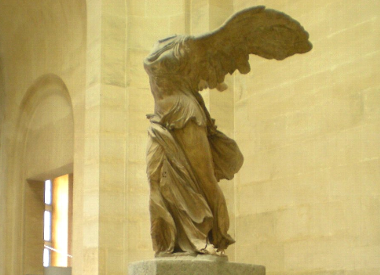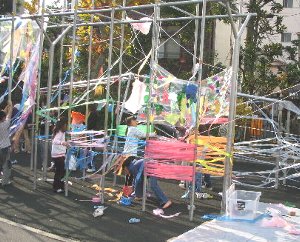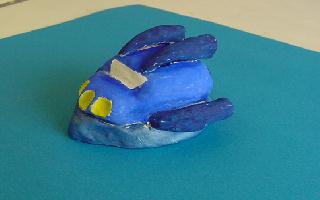美 術 教 育 ・ アート の 力
The Art Education ProgramArt Education Advocacy
美術教育の提唱サイト
Are you losing art teachers and/or art programs in your district?
あなたの地区で、美術の先生、そして/または 美術プログラムを失っていますか?
美 術 教 育 ・ アート の 力
The Art Education ProgramArt Education Advocacy
美術教育の提唱サイト
 |
サモトラケのニケ SamothraceWinged Victory> ルーブル美術館 Louvre, Paris photo(c)Makio Kawashima |
1,あなたは私たちにとって重要な、芸術と他のものについてどのように提唱しますか?
1. How do you advocate for the arts and other things which are important to us?
2,なぜ、21世紀の必須な教育として、美術(ビジュアルアート)の学習がありますか?
2. Why is learning in the visual arts essential to education in the 21st century?
Advocacy Resources - MESSAGE:全米美術教育協会の支持・擁護リソース(メッセージ)
◆Advocacy+Policy National Art Education Association3,芸術教育は、個人と社会のために何をしますか?
3. What does arts education do for the individual and for society?創造性を学生に育むことは、批判的思考、協同、コミュニケーション、現実の問題解決などの横断的なスキルを促進することが示されています。
Exposing students to creativity, also in the teaching of other core subjects, has been shown to promote transversal skills such as critical thinking, collaboration, communication, and real-world problem solving. (Education & Development)
◆ARTS COUNCIL MALTA芸術と創造は、社会の中心として正しい立場を取るべきです。(ユネスコ)
Art and creation must take their rightful place at the heart of society: UNESCO
第1回世界芸術教育会議 2006年3月6-9日、ポルトガル、リスボン :21世紀に向けた創造力の構築
First World Conference on Arts Educationon Arts Education:
Building Creative Capacities for the 21st Century
Lisbon, 6-9 March 2006
〇主な目標は、芸術教育の役割を、子どもがアイデンティティを失うことなくグローバル化した環境で自分の地位に就くための準備を整えるための手段として定義し、芸術教育の取り組みをユネスコの「すべての人のための質の高い教育」に結びつけることです。
The major goal being, to define the role of arts education as an instrument to prepare the child to take his/her place in a globalized environment without loosing his/her identity, and to link arts education efforts to UNESCO’s Quality Education for All.
-----------------------------------
2つの具体的な提案
2 Concrete Proposals:
●「国際的な研究ネットワークを設立して、芸術教育の持続性を促進してください」
Establish international research networks to promote the sustainability of arts education.
●「芸術教育支持のための国際的な指針(ガイド)を作り上げてください」
Elaborate an international guide for arts education advocacy.
Celebrate UNESCO's 1st International Arts Education Week
ユネスコの第1回国際芸術教育週間をお祝いしてください。
UNESCO celebrates the power of art and education across the globe
第2回世界芸術教育会議, 2010年
Second World Conference on Arts Education, 2010
韓国政府が主催し、ユネスコが共催した第2回ユネスコ芸術教育世界会議は、2006年にリスボンで開催された成功した第1回世界会議の成果に基づいて構築されました。
世界中から一流の専門家が芸術と教育に関する貴重なビジョンを交換し、学校環境の内外で芸術教育の重要な役割を強調し、国際社会に対する芸術教育の重要性をさらに訴えました。
第2回芸術教育世界会議の目的
Aims of the Second World Conference on Arts Education
芸術教育の計画指針
Road Map for Arts Education :English
国際芸術教育週間
According to the decision of the 36th session of UNESCO’s General Conference in 2011 (36/C Resolution 38), the 4th week of May was proclaimed as the International Arts Education Week.
International Arts Education Week.
第2回芸術教育世界会議の成功(ソウル、2010)に続いて、2011年の36番目のユネスコ世界会議で、5月の第4週を、国際芸術教育週間として宣言しました。
国際芸術教育週間 2022
International Arts Education Week: May 23-29, 2022.
UNESCO International Arts Education Week
美術教育プログラムの展望は、芸術教育の社会に対する認識を拡げることです。
The Vision of the Art Education Program is to expand public awareness of arts education.
美術教育は、幸せづくり、人づくり、夢づくり、モノづくり、美しさづくり、国づくり、そして平和づくりに貢献します。
Art education contributes to the shaping of happiness, character, dreams, things, beauty, nations, and peace.・人類は誕生以来、衣服を作り、食料を作り、住居を造り、仲間をつくり、そして社会を創ってきました。
・美術とは、これらの方向を示すものです。
・美術とは、これらの本質を考えながら、幸せに関連するすべてのものを作ります。 建仁寺(京都)
"Since their birth, human beings have made clothes, produced food, built houses, made friends and built societies.
Art is something that shows these directions.
Art makes everything related to happiness while considering the essence of these things." -Kenninji Temple (Kyoto)
"Since their birth, human beings have made clothes, produced food, built houses, made friends and built societies.
Art is something that shows these directions.
Art makes everything related to happiness while considering the essence of these things." -Taman Sari Water Castle (Yogyakarta)YouTube 2022 Arts Education Week from Japan Wednesday, 18 May 2022 by Makio Kawashima
◆ユネスコ芸術世界会議(ソウル)での目標(日本語翻訳)
◆Seoul Agenda: Goals for the Development of Arts Education(English)
◆美術教育が目指す16の目標 The Aims of Visual Arts Education
◆美術が教える10の授業(レッスン) 10 Lessons the Arts Teach
◆アートの学力<美に向かう実践力>Practical skills through Art Education
◆美術教育の擁護リンク Art Advocacy and Resources (相互リンク)
◆美術教育のための支持白書 Advocacy White Papers for Art Education
◆芸術から学ぶトップ10の技術 Top 10 skills children learn from the arts
◆芸術教育10の顕著な研究10 Salient Studies on the Arts in Education
◆芸術教育のベスト The Best of Arts in Education
◆芸術教育が重要である理由、そして、誰がそれを良くしますか Why Arts Education Is Crucial, and Who's Doing It Best
◆学校で復活する芸術 Arts making comeback in schools
現在、教育者は科学と工学における創造性の重要性を強調することで、芸術を取り戻しています。彼らはそれをSTEAMと呼びます - STEMに「アーツ」が追加されました。
◆生徒に芸術教育が必要な理由 Why Students Need Arts Education
◆生きるそして未来へ Children live to the future.
◆芸術教育:Arts Education
芸術は、魅了と喜びを提供することから、認知的成長と共感能力を促進することまで、参加する人々に多くの利益をもたらします。さらに、子供の頃の芸術への参加は、大人の参加と密接に関連しており、芸術に触れた子供が今後数年間芸術の活気を保証できる将来の観客になることを示唆しています。{ウォレス財団}The Wallace Foundation
◆学校の芸術プログラムを復活させる努力が勢いを増す
Effort to revive arts programs in schools gains momentum
◆10 Reasons Why Arts in Education is So Important for Kids
◆Art Advocacy for Educators
◆NAEA Arts Advocacy Elementary Division
◆10 Salient Studies on the Arts in Education
◆Study Says Making Art Is Good For Your Brain, And We Say You Should Listen
◆The Importance of Fine Arts Education
◆The Importance of Art in Child Development
◆Top 10 Reasons to Support the Arts in 2014
◆Why Art and Creativity Are Important
◆Ten Reasons Why Art Is Good For Kids
◆Why are the arts important to humans today?Art is important to us humans because of the...
◆11 Facts About Arts in Education
By participating in the Arts Education program, students will:
美術教育によって学生は、●すべて人が成長して偉大な芸術家になるというわけではありませんが 、すべての人が芸術を鑑賞して、購入するかもしれません。 Not all would grow up to be great artists - but all could appreciate art and buy art.
Judy Decker: Incredible Art Department●すべての人が成長して偉大な芸術家になるというわけではありませんが、すべての人が芸術を鑑賞して、美的な人生(世界)を創造するかもしれません。 Not all would grow up to be great artists - but all could appreciate art and create artistic life (world). ◇すべての子供にとって基本的な教育としての美術/The Arts as Basic to Every Child's Education.
◇美術教育の革新/Arts Education's innovation.
◇自由な人生のための壮快で創造的な活動!/Refreshing and creative action for your free life!
「図工・美術の学力サイト」
ART ADVOCACY & PUBLIC RELATIONS
●Learning to Share for Arts Education
美術教育のための、学びの共有
●The goal of these programs is not only to teach our students a variety of arts and art-making skills, but to help enhance them with the skills, knowledge, and attitudes that will benefit them in and out of school.
これらのプログラムの目標は、学生に多様な美術や制作の技術を教えるだけではなく、学校の内外で彼らの役に立つ、技術・知識・態度を教えることです。
ADVOCACY 芸術提言 The Tree of Habits
Eldon Katter
Art is craft
a skill to be practiced.
Art is engagement
a pursuit of fulfillment.
Art is envisioning
an idea to be planned.
Art is expression
a communication of passion.
Art is observation
a perception of humanity.
Art is reflection a process of inquiry.
Art is exploration
a quest of possibilities.
Art is understanding what it means to be human.
Art is design
a prescription for living.
Art is a journey
to seek, to find, to question the past, to anticipate the future, to give new meaning to the old, and to make the ordinary extraordinary.
Art is an integration of habits that make us human.
習性という名の木 エルドン・ケッター
芸術は技能、それは実践する技術。
芸術は約束、それは足るを追及すること。
芸術は想像、それは計画した着想。
芸術は表現、それは熱い想いを伝えること。
芸術は観察、それは人間性を感じること。
芸術は内省、それは探究する過程。
芸術は探検、それは可能性の探求。
芸術は理解、それは人間であるとはいかなることか理解すること。
芸術は設計、それは生の処方を行うこと。
芸術は旅、それは追求し、発見し、過去に疑問を投げかけ、未来を予期し、古きものに新たな意味を与え、普通のことに特別な意味を与える旅。
芸術は、私たちを人間たらしめる習性の総合なのだ。
30 January, 2015 <http://www.schoolartsdigital.com/i/375466/12>.SchoolArts Magazine.
schoolartsonline.com
http://www.schoolartsdigital.com/i/375466/12
●The arts are a way to preserve our history and shape our future.美術は、私たちの歴史を保護して、私たちの未来を形づくる方法です。Environmental Total Design:Art Education Projects「環境を考える美術教育」
●Art Lesson Plans and "Period for Integrated Study Plans"for Elementary School
「図工と総合の時間」授業案
●Communication through art is a universal way.
美術を通しての伝達・交流は、普遍的な方法です。
Incredible Art Department 信じられない美術部門集
●Arts Education reinforce students' literacy skills.
美術教育は生徒の読解技術を補強します。
Ⅰ 美術教育がコアカリキュラム(必修科目)に含まれている成果と理由について記述します。
Described below are the main outcome and the primary reason of including Arts Education in the core curriculum for all students.
1. 美術教育の目指すもの
The Aims of Visual Arts Education
16 Goals for the Development of Visual Arts Education
1.美術教育は手や道具(機械)を使い,生きていくのに必要なモノをつくり出します。(文明の発生)
1. Visual Arts Education uses hands and tools/implements, and creates what we need to live. (Origin of Human Civilization)
2.美術教育は視覚コミュニケーションの様々な方法で,絵画,工芸品,デジタルアート,スタジオ制作,芸術史,美意識,および批評を含む視覚的読み書き能力をもたらします。(視覚的読み書き能力)
2. Visual Arts Education provide visual literacy in the various modes of visual communication to include drawing, craft, digital art, studio production, art history, aesthetics and criticism. (Visual Literacy)3.美術教育は子どもの世界や表現を認め,その年齢の花を咲かせます。(児童性の擁護)
4.美術教育は道具をつくり,それらを美的に使用して地球と世界をデザインします。(道具と技術の調和)
3. Visual Arts Education confirms the world and expression of children, and allows them to express themselves appropriately for their age. (Advocacy of Child-ness)
4. Visual Arts Education creates tools, and designs the earth and the world by using them beautifully.
(Tools and Technology in Harmony)5.美術教育は,子ども一人一人の感覚や表し方の違いを認め,価値の優劣ではなく,それぞれの想いを生かした花を咲かせます。(個性の尊重)
6.美術教育は視覚(映像)を利用して思考し、ことばや数に具体的なイメージを統合します。(視覚的思考)
5. Visual Arts Education confirms each child’s individual sense and expressiveness, assigns to relative values, and allows children to express their own feelings. (Respect of Individuality)
6. Visual Arts Education thinks using eyesight/images, and integrates concrete images into words and numbers. (Visual Thinking)7.美術教育は知識や手先の技術よりも,子どもに夢やつくる楽しさを教えようとします。(創造の喜び)
7. Visual Arts Education attempts to teach children to dream and to experience the joy of creation, not knowledge or skills alone. (Joy of Creativity)そのために,美術教育は基本の指導をしながらも,多様な造形体験を重視します。(造形の意欲)
For that reason, visual art education teaches the basics while emphasizing multiple kinds of creative art experiences. (Enthusiasm for Creativity)8.美術教育は子どもが作品を生みだす<表現・鑑賞>の具体的な活動を通して,いろいろな表現や自分の生き方を学びます。(自己表現)
8. Visual Arts Education uses the specific “expressive and appreciative” activities that children use to create art to teach them to express themselves in many ways and to live their own lives. (Self-expression)9.美術教育は人や道具・材料・知識など様々な関わりのなかで,統合することや協調することを学びます。(自己調節と協力)(実地のプロジェクト)
9. Visual Arts Education teaches integration and harmony in the various relationships between people, as well as in tools, materials, and knowledge. (Self-control and Cooperation) (Hands-on Projects)
10.美術教育は破壊的なエネルギーを建設的な美術作品に変えます。(芸術療法)
10. Visual Arts Education turns Destructive Energy into Constructive Artwork. (Art Therapy)11.美術教育は子どもたちが主体的に活動することを願い,○○方式など,指導者が一方的に指示するような方法に反対します。(画一化への反対)
11. Visual Arts Education aims at child-focused activities, and is opposed to instructors teaching unilaterally using particular teaching methods such as XX. (Opposition to Uniformity)12.美術教育は,造形に対する幅広い専門性と児童に対する愛情を基に,一人一人の子どもに適した指導を試みようとします。(個に応じた指導)
12. Visual Arts Education is based on a broad specialization in creative arts and consideration for children. Individualized instruction appropriate to each child is the ideal. (Individual Instruction)13.美術教育は生涯にわたって造形に親しみ,美を感じ,豊かに自分を表現できるような人間性を養っています。(自己実現)
14. 美術教育は人類の真の発展のために文化芸術を高め,伝統的文化財や著作権を保護します。(文化芸術の保護及び発展)
13. Visual Arts Education develops a lifelong love of creative arts, a sense of beauty, and a rich capacity for self expression. (Self-realization)
14. Visual Arts Education enhances culture and fine arts for real development of human beings, and protects traditional cultural assets and copyrights. (Protection and Development of Culture and Fine Arts)15.美術教育は未来のあらゆる課題や問題に対して,創造的に対処して,主体的に行動できる人間を目指しています。(未来や社会の形成力)
15. Visual Arts Education aims to build personalities able to deal proactively with all future issues with creativity and with self-sufficiency. (Contributing to the Society of the Future)
16.美術教育は,生徒に平和の展望をつくるように勧めています。(平和への行動)
16. Visual Arts Education is inviting students to create a vision of Peace. (Peacemaking !)
◆相互リンク [Reciprocal link] Incredible Art Resources/Art Advocacy and Resources
Copyright (C) 2010-2021 Makio Kawashima, Japan. All Rights Reserved.
「ゆとり」から「確かな学力」への移行と美術教育
1. 21世紀を展望した我が国の教育の在り方について<中央教育審議会 審議会答申等 (第一次答申) 1996/7>
2. 21世紀を展望した我が国の教育の在り方について<中央教育審議会第二次答申1997/6>
3. 初等中等教育における当面の教育課程及び指導の充実・改善方策について<中央教育審議会答申2003/10>
第2章 子どもたちに求められる学力についての基本的な考え方
|
*説明に図のテキスト化(カタカナ,数字は,筆者追加)を使用する。
・確かな学力:タ1ー知識・技能に加え,タ2ー自分で課題を見付け,タ3ー自ら学び,タ4ー主体的に判断し,タ5ー行動し,タ6ーよりよく問題を解決する資質や能力
・確かな学力の分析図(ブ:基礎・基本を同心円の中心にして,
①知識・技能,②学ぶ意欲,③課題発見能力,④思考力,⑤判断力,⑥問題解決能力,⑦表現力,⑧学び方,の8つの学力をあげている。
|
||
5 総合的な学習の時間とのかかわり
2.生きる力と美術教育The Vision of the Teaching for Artistic Behavior
 <Art Project>
<Art Project>
ふれるかたち ふれるいろ ~光を通して~
| 東京都図画工作研究大会 城東大会 授業記録 Art Project |
|
2005年12月2日 墨田区立曳舟小学校 |
1.[生きる力]は、全人的な力
2. 国際的な美術教育のねらいArts World Wide: Visual Arts Curriculum
|
ここでは、3つの生きる力と対応しながら,知識・技能を実社会の中で活用する能力を考察しています。
*記号・数字は、文部科学省の示す3つの生きる力(下表参照)に対応して説明しています。
A 豊かな人間性 B 確かな学力 C 健やかな体 |
||
B 確かな学力(美に向かう体験的な学力)<文化的基礎・美術は交流するための基本的な言語です>A②B①④C①
| ◆*Artistic Education 芸術的な教育 Encouraging development of the arts by means of art education is one way of promoting cultural diversity. Young people are a natural target for action programmes aimed at bringing about democratization in art and culture. The teaching of artistic and cultural disciplines should therefore be encouraged: not only music and the plastic arts but also dance, theatre, poetry and the oral tradition. 芸術教育によって芸術の発展を促進することは、文化的多様性を促進する方法です。若者には、芸術と文化で民主化をもたらす活動プログラムは自然な目標です。それゆえに、芸術的で文化的修養の授業は促進されるべきです:音楽と造形美術のみでなく、ダンス、演劇、詩、そして口述の伝統も。 |
A 豊かな人間性(文化的体験,コミュニケーション能力)
C 健やかな体(自己の自然な表現欲求)
A 豊かな人間性 B確かな学力 C健やかな体(健康・体力) ①自分を律する。<自己コントロール>ii) 正義感や公正さを重んじる心
v) 自立心、自己抑制力、責任感
②他人との協調 <協調性>
iii)生命を大切にし、人権を尊重する心などの基本的な倫理観
vi) 他者との共生や異質なものへの寛容
③思いやる心<人間愛・他者理解>
iv) 他人を思いやる心や社会貢献の精神
④感動する心<人間的感性>
i) 美しいものや自然に感動する心などの柔らかな感性
①知識・技術
knowledge(学習・経験による知識)
information(他から与えられる知識)
learning(学び得た学識)
acquaintance(体験による知識)
*ニューセンチェリー和英辞典(三省堂)より
②学ぶ意欲
eager student,
motivation to study
③問題解決能力
one's problem-solving powers
④表現力
power of expression; ability to express the self;
in one's peculiar style of expression
⑤判断力judgment; ability to judge; sense;
⑥思考力thinking power;
⑦課題発見能力
find out a new theme
⑧学び方good way of learning
(生涯学習)lifelong study
①たくましく生きるための健康
<食事・健康管理、自己表現・表出>
②たくましく生きるための体力
<自己防衛、運動能力・身体表現>
3.アートの学力:Academic Ability in Art
 |
 |
| よいクルマをつくろう Produce A Ecology-Conscious Car |
よいロボットをつくろう Human Design"Good Robot Production" |
| 「芸術が教える10の授業(レッスン)」 エリオット・アイスナーによって <10 Lessons the Arts Teach> By Elliot Eisner National Art Education Association 1. The arts teach children to make good judgments about qualitative relationships. Unlike much of the curriculum in which correct answers and rules prevail, in the arts, it is judgment rather than rules that prevail. 芸術はこどもたちに質的な関係(例えばどちらがよいかどうか、どちらが正しいかどうか)についての判断能力を育てる。正しいかどうかの(画一的な)答えや一般的に普及している規則を教えるだけの他の多くのカリキュラムと異なり、芸術はそれよりも(価値のある)判断能力を養うことができる。 2. The arts teach children that problems can have more than one solution and that questions can have more than one answer. 芸術は子供に、問題には複数の解決を持つことができること、質問には複数の答えを持つことができることを教える。 3. The arts celebrate multiple perspectives. One of their large lessons is that there are many ways to see and interpret the world. 芸術は多角的視野を育て(推奨す)る。芸術の大きな(重要な)レッスンの一つは世界(で何が起こっているか)を視覚し、それを解釈するには、多くの方法があるということを教えることである。 4. The arts teach children that in complex forms of problem solving purposes are seldom fixed, but change with circumstance and opportunity. Learning in the arts requires the ability and a willingness to surrender to the unanticipated possibilities of the work as it unfolds. 芸術は複雑な形で存在する問題解決のプロセスや目的はひとつではないことを教えてくれる。しかしまたその問題解決方法は状況や機会によって変化する(すべき)のである。芸術において学ぶということは、予測できないことがおきたときにも常にそれに対応する意思の力と能力を要求する。 5. The arts make vivid the fact that neither words in their literal form nor number exhaust what we can know. The limits of our language do not define the limits of our cognition. 芸術は言語や数字が我々が知っている事を表現しえないということを明確にしてくれる。われわれの言語の限界は我々の認知に限界があることを意味してはいない。(つまり、ここで言いたいのは「芸術は言語によって表現できないことを表現することができる。」<徳先生注釈> 6. The arts teach students that small differences can have large effects. The arts traffic in subtleties. 芸術は小さな違いであってもそれが大きな効果(拡大拡散)につながるということ教えてくれる。*芸術は微妙で繊細なものなのである。 7. The arts teach students to think through and within a material. All art forms employ some means through which images become real. 芸術は、素材を通して、そして素材の中において思考することを教える。 すべての芸術の形は、イメージを現実化させたもの(もしくは実体化するプロセス)である。 8. The arts help children learn to say what cannot be said. When children are invited to disclose what a work of art helps them feel, they must reach into their poetic capacities to find the words that will do the job. 芸術はこどもたちが言葉で表現できないことを表現できるということを学ばせることができる。 *こどもたちが芸術作品から何かを感じ取る時、彼らは彼ら自身の詩的能力に目覚め、 それを表現する言葉を見つけ出さなければならない。 9. The arts enable us to have experience we can have from no other source and through such experience to discover the range and variety of what we are capable of feeling. 芸術は他のどんなことからも学ぶことができないことを経験させてくれる。そしてその経験を通して感じること(感受性)の多様性とその幅の広さを発見することができる。 10. The arts’position in the school curriculum symbolizes to the young what adults believe is important. 学校教育における芸術(教育)の位置は、子どもに対しても大人が何を信じているかが重要であることを象徴をもしているのである。(つまり大人自身が芸術の価値を学校のカリキュラムにおいて正しく伝えないと子どもだって芸術を大切だなんて思わないよということです。)<徳先生注釈> SOURCE: Eisner, E. (2002). The Arts and the Creation of Mind, In Chapter 4, What the Arts Teach and How It Shows. (pp. 70-92). Yale University Press. Available from NAEA Publications. <翻訳>徳 雅美 先生 (カリフォルニア州立大学) |
自己表現と自己伝達
連絡:CONTACT US
アートeラーニングセンター:Art e-Learning Center
日本美術教育会:Art Lesson Plans for Teachers
LINKS ![]() 図工・美術の大切さを訴える|
図工・美術の大切さを訴える|![]() 日本学校音楽教育実践学会Japan Association for the Study of
School Music Educational Practice
日本学校音楽教育実践学会Japan Association for the Study of
School Music Educational Practice![]() 現行の学習指導要領の成果と課題,見直しに関する意見(例)-芸術-
現行の学習指導要領の成果と課題,見直しに関する意見(例)-芸術-![]() がんばれ!図工の時間
がんばれ!図工の時間
![]() 図工・美術のeラーニングArt e-Learning
図工・美術のeラーニングArt e-Learning ![]() 子どもアートオリンピックJapan Arts Olympiad
子どもアートオリンピックJapan Arts Olympiad
World School Galleries:子ども美術館
STUDENT ART GALLERIES Shinozaki Elementary School International Child Art Foundation UKITA ART MUSEUM Children's Site : Yuvabadhana Foundation
文化芸術の振興に関する基本的な方針の見直しについて
(答申)
https://www.mext.go.jp/b_menu/shingi/bunka/toushin/07022805/001.pdf
平成1 9 年2 月2 日文化審議会
第1 文化芸術の振興の基本的方向
1.文化芸術の振興の意義
文化は,最も広くとらえると,人間の自然とのかかわりや風土の中で生まれ,育ち,身に付けていく立ち居振る舞いや,衣食住をはじめとする暮らし,生活様式,価値観など,およそ人間と人間の生活にかかわる総体を意味する。
一方,文化を「人間が理想を実現していくための精神活動及びその成果」という視点でとらえると,文化の中核を成す芸術,メディア芸術,伝統芸能,芸能,生活文化,国民娯楽,出版物,文化財などを示す文化芸術の意義については,次のように整理できる。
文化芸術は,①人間が人間らしく生きるための糧となるものであり,②人間相互の連帯感を生み出し,共に生きる社会の基盤を形成するものである。また,③より質の高い経済活動を実現するとともに,④科学技術や情報化の進展が人類の真の発展に貢献するよう支えるものである。さらに,⑤文化の多様性を維持し,世界平和の礎となるものである。
このような文化芸術は,すべての国民が真にゆとりと潤いの実感できる心豊かな生活を実現していく上で不可欠なものであり,国民全体の社会的財産である。
今日では,文化芸術の持つ,人々を引き付ける魅力や社会に与える影響力,すなわち,「文化力」が国の力であるということが世界的にも認識され,また,文化芸術が経済活動において新たな需要や高い付加価値を生み出す源泉ともなっており,文化芸術と経済は密接に関連しあうと考えられるようになった。
我が国は,今後一層文化芸術を振興することにより,心豊かな国民生活を実現するとともに,活力ある社会を構築して国の魅力を高め,経済力のみならず文化力により世界から評価される国へと発展していくこと,換言すれば,文化芸術で国づくりを進める「文化芸術立国」を目指すことが必要である。
2.文化芸術の振興に当たっての基本的視点
第1次基本方針と同様,第2次基本方針においても,基本法第2条に掲げられた八つの基本理念(①文化芸術活動を行う者の自主性の尊重,②文化芸術活動を行う者の創造性の尊重及び地位の向上,③文化芸術を鑑賞,参加,創造することができる環境の整備,④我が国及び世界の文化芸術の発展,⑤多様な文化芸術の保護及び発展,⑥各地域の特色ある文化芸術の発展,⑦我が国の文化芸術の世界への発信及び⑧国民の意見の反映)にのっとり,施策を総合的に策定し,実施する。
(1)第1次基本方針策定後の諸情勢の変化
第1次基本方針の策定後も,国内外の諸情勢は急速な変化を続け,文化芸術を取り巻く状況にも大きな影響を与えている。
国内では,構造改革の進展により,民間と行政の役割分担の見直しや地方分権の推進等が図られた一方,地方公共団体の文化関係経費は,厳しさを増す財政状況の中で減少傾向にある。また,規制緩和などにより新たな分野への民間の進出が可能となり,多様なサービスが効率的に提供されることへの
期待が高まっている。
民間部門では,非営利活動やボランティア活動などが広がったことに伴い,民間と行政の協働による新たな取組が進められ,企業のメセナ活動も多様な広がりを見せている。
公立文化施設に対しては,指定管理者制度の導入により,民間の新たな発想や方法(ノウハウ)による効果的かつ効率的な運営が期待される一方で,これまで地域で培われてきた文化芸術活動の安定的かつ継続的な展開が困難になるとの懸念も現場から指摘されている。
地方においては,過疎化や少子高齢化の進展等により,文化芸術の担い手が不足してきており,都市部においても単身世帯が急速に増加していることなどから,地域社会(コミュニティー)の衰退が指摘されている。また,大規模な市町村合併により,地域に根ざした文化芸術の継承が危ぶまれている。
国際的には,政治,経済における地球規模化(グローバリゼーション)の進展に伴い,文化芸術による創造的な相互交流が促進される一方,文化的アイデンティティーの危機をめぐる緊張が高まり,文化の多様性が脅かされることが懸念されている。これを背景に,国際連合教育科学文化機関(ユネスコ)では,2005年(平成17年)10月に「文化的表現の多様性の保護及び促進に関する条約」が採択された。
また,インターネットをはじめとする情報通信技術の発展と普及は,あらゆる分野において,国境を越えた対話や交流を活発化させ,情報の受信・発信を容易にしたが,その一方で,人間関係の希薄化,実体験の不足といった負の側面も指摘されている。
(2)基本的視点
ⅰ)文化力の時代を拓く
美しい自然や歴史・伝統に基づく文化芸術は,人々に精神的な豊かさや感動を与えるとともに,人々のコミュニケーションを活発化し,生きる勇気と喜びをもたらす普遍的な力を持っている。
世界の国々は文化芸術の発信により国の魅力を高め,異国の文化芸術の受容や相互交流を通じて世界の文化芸術の発展に寄与しようとしている。我が国も,伝統文化から現代文化まで多様な文化芸術を振興し,文化力を高め,心豊かで活力にあふれた社会を実現していくことが必要である。あわせて,国際文化交流を推進することによって,我が国についての理解を促進し,イメージの向上を図るとともに,文化芸術を通じて世界に貢献する必要がある。
また,文化芸術は,古今東西の様々な人々の営為の上に生まれ,その継承と変化の中で新たな価値が見い出されていくものであり,短期的な視点のみでその価値を計ることは困難である。こうした文化芸術の特質を踏まえ,文化芸術活動に短期的な経済的効率性を一律に求めるのではなく,長期的かつ継続的な視点に立った施策を展開する必要がある。
ⅱ)文化力で地域から日本を元気にする
我が国は長い歴史の中で,諸外国との交流などを通じて様々な文化芸術を受け入れつつ,全国各地で多様かつ特色ある文化芸術を創造し,継承し,発展させてきた。この地域文化の厚みが日本文化の基盤を成している。すなわち,地域文化が豊かになるほど日本文化全体も豊かになり,日本の魅力が高まる。以下略
------------------------------------
◎文化芸術の振興に関する基本的な方針ー文化芸術資源で未来をつくるー(第4次)について(答申)
<文化庁>Agency for Cultural Affairs
![]() (C) 2005-2022 Art e-Learning Center, Makio Kawashima , JAPAN
(C) 2005-2022 Art e-Learning Center, Makio Kawashima , JAPAN
| 図工室VISUAL ARTS | パソコン室Computer Art Museum
Incredible Art Lesson Plans |図画工作・美術科の学習プラン集: 相互リンク Reciprocal link
Wednesday, 18 May 2022